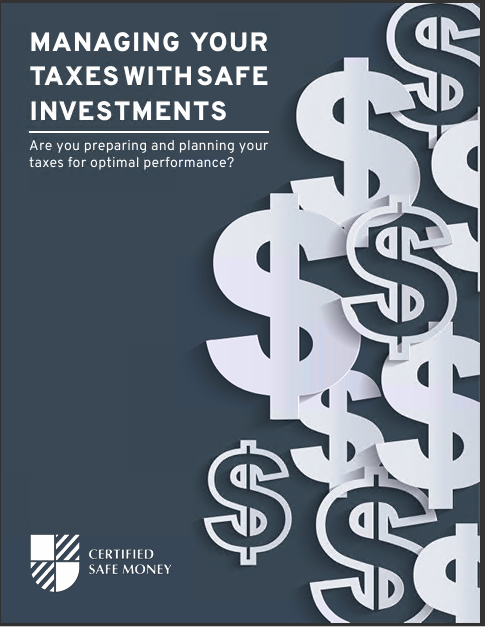Safe Money Basics What is Safe Money?
As you get closer to retirement, ensuring that your savings are protected can become one of your primary financial goals. There are a number of safe money investment options that you could choose from, depending on your financial objectives, risk tolerance, and time frame for retirement. But just exactly what is safe money?
Safe Money Investment Options
Safe money is defined as a place to put your money that has no stock market risk and guarantees your principal will not go down in value. Keeping your money safe will allow you to sleep much better at night – even if the stock market plummets as it did during the 2008 recession and the 2020 COVID-19 pandemic (and corresponding market downturn). As an added bonus, because there are no losses to make up for with some safe money investments, the growth can continue to compound over time. Some of the most common safe money options include: United States Treasuries
CDs (Certificates of Deposit)
Fixed Annuities
Find the most credible, highest-rated Safe Money advisors in your area.
If you are nearing retirement or already retired, you should consider safe money because your future is too bright to risk. United States Treasuries In order to fund its operations, the United States government offers various fixed income securities. These include Treasury bills, Treasury notes, and Treasury bonds. While all of the names may sound alike, these investments can have some significant differences. For example, each of these financial vehicles offers a different time period until maturity. In addition, each of these instruments also pays interest in a different way. So, before you commit to any type of Treasury investment, it is important to understand how they work. Treasury bills – which are also oftentimes referred to as T-bills – are short-term U.S. government debt obligations that are backed by the United Treasury Department. These investments have maturities of one year or less – in some cases, only a few days. The interest that is received from Treasury bills is not taxed at the state or local level. However, it is subject to federal income taxation. These securities are typically sold in $1,000 denominations. T-bills with longer maturity dates will usually pay a higher rate of interest. However, in return for their safety, these “risk-free” financial vehicles generally pay very low rates. A Treasury note (or T-note) is a government debt security that offers a fixed interest rate and maturities of two, three, five, seven, or ten years. Similar to with Treasury bills, the longer the maturity is on a Treasury note, the higher the interest rate will usually be. Interest is paid out to Treasury note investors every six months until the note has matured. At that time, the investor will also receive their principal back. The income that is received from T-note investments is not taxable on a state or municipal level. However, the money is federally taxed. Treasury bonds, or T-bonds, mature in 10 or more (up to 30) years. These bonds earn periodic interest and pay out this interest twice each year to the investor until maturity. At that time, the investor is paid a “par” (or face value) amount that is equal to the bond’s principal. Regardless of the maturity you choose, the minimum amount of money you can invest in a Treasury bond is $1,000. Initially, T-bonds are sold through auction. Then, after the auction, these bonds may be sold in the secondary market. While Treasury notes, bills, and bonds are all considered safe money – and they are backed by the “full faith and credit” of the United States government the return that is generated from Treasuries is typically quite low. With that in mind, many investors will purchase Treasuries to diversify other, more risky, investments and balance out the overall risk in their portfolios. Certificates of Deposit (CDs) Certificates of Deposit, also known as CDs, are financial products offered through banks and credit unions. In exchange for a deposit, investors are paid a set interest rate over a certain amount of time. The maturities on CDs can range from just 21 days up to ten years. As with U.S. Treasuries, the longer the maturity is on a CD, the higher the interest rate. Investors are able to receive their principal back prior to the CD’s maturity. However, they are usually penalized for doing so. The interest that is received from a certificate of deposit is taxable (although the principal is returned tax-free). Many people purchase CDs as a safe money option. However, because the rates on CDs are also quite low, they are usually just one component of investors’ overall portfolios. Fixed Annuities Another safe money option is fixed annuities. These financial vehicles pay a stated rate of interest that the offering insurance company sets, and they keep your principal safe, no matter what occurs in the stock market. The funds that are inside of a fixed annuity are allowed to grow on a tax-deferred basis. This means that there is no tax due on the gain until the time of withdrawal. Another highly attractive feature of fixed annuities is that they can pay out a set income stream, either for a certain amount of time (like ten or twenty years) or even for the remainder of your lifetime, regardless of how long that may be. This can help to alleviate the concern that many retirees have of outliving their income in retirement. If a fixed annuity is purchased using after-tax dollars, the income that is received will be partially taxable as ordinary income. For example, each income payment will consist in part of taxable gain and in part of the non-taxable return of principal. Fixed annuities may also have other features, such as a death benefit paid out to a beneficiary if the annuitant (i.e., the income recipient) passes away before receiving their contribution back. These financial options may also allow penalty-free withdrawals – even during the annuity’s surrender charge period – if the annuitant is either diagnosed with a terminal illness or is required to reside in a nursing home for a certain period of time (usually 90 or more days). Many investors fund fixed annuities with lump sum “rollovers” from IRAs (Individual Retirement Accounts) or employer-sponsored retirement plans, such as a 401(k). Doing so can provide a way to convert many years of savings into a reliable income stream in retirement. The income and other guarantees offered by fixed annuities are reliant on the offering insurance company’s financial strength. So, before committing to an annuity, it is important to check the insurer’s ratings from Standard Poor’s, A.M. Best, Fitch Ratings, or Moody’s Investor Services. A fixed annuity can be a good safe money option for those who want to keep their principal safe in any market environment and know that they will have a reliable, ongoing stream of future income. Because most annuities impose a surrender, or withdrawal, penalty if more than 10% of the account value is accessed within a set period of time, these financial vehicles should always be considered long-term commitments. Therefore, they should not be funded with money that may be needed in the near future for emergencies or other financial obligations. Fixed Indexed Annuities One type of fixed annuity that has gained popularity over the past several years is the fixed indexed annuity. The return on these annuities is based in large part on the performance of an underlying market index, such as the SP 500. In years when the index performs well, a positive return is credited to the annuity – usually up to a certain limit, or “cap.” But in years where the underlying index performs poorly, there is no loss in the account. Rather, it is simply credited with a 0% for that time period. As with other annuities, the growth that takes place in a fixed indexed annuity is tax-deferred. Similarly, there are typically several income payout options to choose from, including the receipt of an income stream for life. Because they keep principal safe, fixed indexed annuities are also considered a good safe money alternative that also provides the ability to earn a higher rate of growth than a regular fixed annuity (as well as many other safe money options CDs and U.S. Treasuries).
How to Create a Safe Money Portfolio
Making sure that your money is safe from market downturns and other potential risks is important – especially as you move closer to retirement. But being “too safe” can also have some drawbacks, such as producing a low return and reducing your future purchasing power. With that in mind, it is recommended that you work with a financial professional who is well-versed in setting up retirement and income plans. Doing so can also allow you to look at other financial options that you may not have otherwise considered but that can more closely fit with your goals.













